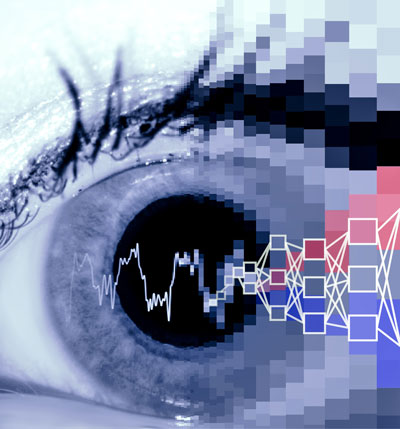Neurodevelopmental disorders often aren’t diagnosed until a child is four years or older, when behavioral interventions and speech/occupational therapy are less effective. Early and quantitative biomarkers of altered developmental trajectories are thus crucial for successful therapies. Arousal is an intrinsic property of the brain that can be quantified non-invasively by measuring spontaneous changes in pupil size or heart rate. We used deep learning to identify temporal patterns of arousal typical of neurodevelopmental disorders in mice, and then, using a technique known as transfer learning, we transferred this information to early detect such patterns in patients with a neurodevelopmental disorder known as Rett Syndrome, with an accuracy of 80% in the first and second year of life.

Figure: Spontaneous fluctuations in pupil size and heart rate are proxies of autonomic arousal, which is altered in neurodevelopmental disorders.
Neurodevelopmental disorders are typically diagnosed (e.g., autism at four years old) beyond the critical period for many sensory, perceptual, and language functions. Translational, quantitative and non-invasive biomarkers for early diagnosis are urgently needed to spur intervention. As an indicator of internal dynamic neuro-modulatory activity in the brain, spontaneous arousal fluctuations are easily detected by measuring time-series pupil size or heart rate variability. Here, we show that both idiopathic (BTBR) and monogenic (CDKL5- or MeCP2-deficient) mouse models of autism display early, aberrant arousal states linked to altered cholinergic signaling. In the MeCP2-deficient mouse model of Rett Syndrome, such arousal abnormalities were already detectable prior to regression and were reversed by the selective re-expression of MeCP2 in cholinergic neurons.
To robustly detect subtle patterns, we trained a deep convolutional neural network (ConvNetACh) to recognize signatures of altered arousal fluctuations due to altered cholinergic tone. We used spontaneous pupil fluctuation data from LYNX1-deficient mice (carrying a deliberately enhanced nicotinic receptor sensitivity) and their wild-type littermates to train ConvNetACh, reaching 97% accuracy. This in turn successfully detected impairments across all autism mouse models tested except in those MeCP2-deficient mice wherein the cholinergic circuit had been rescued.
Moreover, a selective re-training of only the last layers of the mouse ConvNetACh using heart rate fluctuations collected in Rett Syndrome patients (where steady eye gaze is difficult to obtain), generated a neural network (ConvNetPatients) capable of distinguishing them from typically developing subjects. Our transfer learning study is the first across species and modalities, exhibiting significant accuracy even with a small cohort of rare patients, reaching 80% accuracy between the first and second year of life, and up to 88% in stage III patients.
Together, these results indicate that distinct autism models share early-onset arousal abnormalities reflecting altered cholinergic circuitry. Probing spontaneous arousal fluctuations as a proxy with deep learning represents a new tool for their early detection and potential intervention.


































